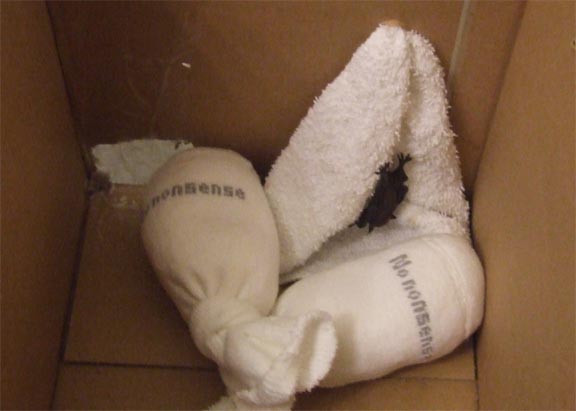I've learned a lot more about caring for baby bats since I posted this in 2010.
Please visit Baby Bats, Spring 2012 for more accurate information.
In June 2005, I rescued a baby Big Brown Bat that had fallen from the louvers of my attic where a maternal colony roosts each spring/summer. Been there, done that, did it again in June 2010!
Around 11 pm on the night of June 1, 2010, I heard incessant peeping--and it wasn't coming from the louvers. I got a flashlight and sure enough, there was a baby on the ground near the basement door. Fortunately, I knew how to care for it until I could get it to a licensed wildlife rehabilitator, so I found a box, brought it inside and (WEARING GLOVES!) gave it a tiny bit of Pedialyte.

These bats are crevice dwellers and they are very, very good at hanging by their toes upside down from a piece of fabric. I grabbed a washcloth to give it a place to hide (which I later replaced it with a piece of old t-shirt--terry isn't good for them because they can get their toes caught!) and filled a couple of socks with uncooked rice, heated them in the microwave for about 45 seconds and put them in the box with the baby to help keep it warm.
The next morning I called Robin Eastham, a local bat and wildlife rehabilitator in Virginia, and she remembered me from 2005. She said she'd like for me to keep it to see if the mother would come get it, but said I could come pick up some goat's milk, which would provide both nutrition and hydration. After I got home with the milk, I offered some to the baby and it quickly figured out how to suck the milk out of a fine paintbrush.


I fed it some room-temperature goat's milk about every two hours during the afternoon and evening, and put together a special "house" from which the mother might be able to retrieve it.


Similar to what Robin helped me with in 2005, the box had a piece of mesh on the back wall with a piece of thin fabric partially covering the mesh. The fabric would give the baby a place to hide, and yet (at least in theory) the mother would be able to access it easily. I put a tarp under the ladder just to be able to better see the baby if it happened to fall or crawl out of the box, and the ladder was located in a part of the yard that is one of the major "flight paths" of the bats as they exit the louvers.

I fed the baby again around 7:45 pm...

...gently put it in the box, along with a couple of warmed rice-filled socks...
...and I waited.
The baby did its part--chirping and peeping and calling out to a mom who never came. Finally around 1:30 a.m. I brought it inside, fed it a bit of goat's milk and put it back in the box.
On the morning of June 3, 2010, I was shocked to see it lying on the bottom of the box and I was afraid it was dead (since I usually find it hanging upside down in the box). When I gently touched it with a gloved finger, it stirred, so I picked it up and gave it some milk. When I fed it again a couple of hours later, it was more alert and ate well:
June 4, 2010
I had planned to take the baby to Robin, the wildlife specialist, on the evening of June 3, but given the severe storms in the area, we decided to wait until morning. It ate eagerly during its first feeding, and before leaving the house I offered it a bit of water, which it sucked out of the paintbrush. Again I was surprised by how strong it was for one so small! I was trying to keep one hand free to video the following clip, and it was able to hang on to the brush with its jaws--and then grabbed it and held it with its "hands"!
After it drank its fill of water, I transferred it to a small box that I'd preheated with a warm, rice-filled sock, and delivered it to Robin's farm in the early afternoon. I had to fill out a short info sheet regarding where it had been found and list my contact information. She said that she would let me know how it did, adding that so far this year she had only been able to save a little more half of the baby bats that had been brought in. She considered that to be a disappointing statistic.
When I got home, I quickly scanned the ground and bushes for other fallen babies. Seeing none, I then looked up at the louvers and said a quick prayer for the rest of the Big Brown bats who choose to raise their young here each year:
And fly away together in the early fall.

As I say on each of the "bat pages" on my website, I was caring for this baby Big Brown bat with the support of a licensed wildlife rehabilitator. As a safety-conscious rescuer and temporary caregiver, I can help keep a young or injured wild animal warm and hydrated, but turning it over to a wildlife specialist gives it the best possible chance of surviving and someday returning to its natural habitat, where it belongs.
There is so much misinformation, superstition and fear about bats. One long-standing myth is that "all bats" are rabid. Not true! Less than one-half of one percent of bats contract rabies, but that said, it is important to remember that any frightened or injured wild animal can bite! For that reason, no bat should be handled with bare hands. Wildlife rehabilitators who plan to work with rabies vector species must receive a series of pre-exposure rabies vaccinations before they can be licensed.
I think that our cultural view of bats has been largely shaped by frightening images of "Dracula" and Halloween, and by what little most people know about real vampire bats. By contrast, in China bats are seen as symbols of happiness, longevity and good luck!
The unfortunate bat in a house--scared witless and usually being chased by a frantic human armed with a tennis racket or broom--is certainly going to look and sound as fierce as it possibly can. Additionally, most pictures of bats show them in a defensive posture, and that has only served to perpetuate the very negative and scary image that people have of them.
Bats are mammals, meaning that the babies are born alive and suckle milk from their mothers. On average, female bats give birth to just one baby per year, and they can live for 20 years! They are more closely related to primates than they are to rodents, and they are not blind. Many species of bats are in danger of extinction due to White Nose Syndrome, loss of habitat, and accidental or intentional eradication and extermination due to human fear and ignorance.
For more information about these highly intelligent, vitally important and gentle creatures, please follow the links below.
Bat World Sanctuary and Educational Center
Bat World Sanctuary on Facebook
Bat Conservation International, Inc.
Bat Rescue Resources by State
What is Killing the Bats? (Smithsonian Magazine, August 2011)
The Bat Lady (ConnectKids website, 2007)
Bat-Related Articles on my Website
Baby Bats, Spring 2012
Baby Bats, Spring 2011
Big Brown Bat, Winter 2011
Baby Bat, 2010
Baby Bat, 2005
Other Resources
Highly recommended for those interested in the science behind animal behavior: